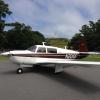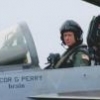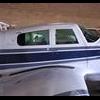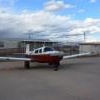Search the Community
Showing results for tags 'safety'.
-
A recent in-flight incident concerning a hopelessly jammed stabilizer trim on a K model prompted increased attention to an obscure Mooney Service Instruction (M20-88), and most likely a new Service Bulletin will be released soon. I have written an article that will deal with this subject in more detail in forthcoming issues of the MAPA Log and The Mooney Flyer but wanted to get the word out to the troops sooner so am posting an excerpt here. This problem may occur on K and earlier model Mooneys but here are some generalized procedures you may find useful for stab trim issues in any Mooney. Stabilizer Trim Problem Actions: Jammed Stabilizer—full nose up: The faster the plane goes the more forward elevator pressure will be required, so slow down as much as possible because this force can be considerable. Lower the flaps (takeoff or landing setting as appropriate), fly with the gear up, and use the least power needed… i.e. no need to climb quickly unless you have obstacle or terrain issues. Try to break the jammed trim loose by “shocking” the trim wheel smartly with as much nose down force (front of trim wheel towards the floor) as you can, but don’t forget to fly the plane. Declare an emergency! Pick a suitable airport (a longer runway is better). Configure normally for landing and fly a stabilized approach in the 1.2 to 1.3 VSO speed range. A slightly steeper than normal glideslope will also help. Slowly retard the throttle when landing is assured, flare, and touchdown normally. Jammed Stabilizer—mid position: Not as critical as the full nose up jam previously discussed, but it will still get your attention. It could be caused by a mechanical failure, a foreign object (e.g. rag, pen, flashlight, seat belt) getting lodged in the mechanism, or ice. Turn off Elevator Trim and Autopilot. Apply a moderate amount of manual trim in the direction opposite to that which caused the jam in the first place and consider jostling the plane in an attempt to dislodge foreign objects. (Don’t get overly aggressive—remember the Air Alaska MD-80 that tried to fix a stab trim problem rather than landing.) Land as soon as practical. If the out-of-trim condition is causing problems controlling the aircraft declare an emergency. Consider a no-flap landing (add 10 knots to VREF) if the trim is jammed nose down. Runaway Trim: Grab the trim wheel to stop the motion. The trim motor clutch will slip allowing you to restrain the wheel. Turn off the Elevator Trim switch and disconnect the Autopilot. Some airplanes have a Trim circuit breaker you can pull. Use manual trim. Be sure always to check the trim position prior to takeoff. Improperly set nose trim can make pitch control very challenging. Excess nose down trim will make rotation difficult and can result in porpoising on the runway and a possible prop strike. Excess nose up trim will make it difficult to keep climb attitude and airspeed under control. You can check your Mooney’s trim system yourself to see if it exhibits any tendency to stick at the limits. On the ground, run the trim to the full nose up position and then back slightly to see if there is any tendency to bind at the stop. Then run it to the stop again and give it “a little extra” with the manual trim wheel to see if it exhibits any tendency to stick. Check with your A&P or MSC if you have any concerns about your trim system. Lee Fox
- 37 replies
-
- 6
-

-
- stabilizer trim
- safety
-
(and 1 more)
Tagged with:
-
Sometimes laser-pointer idiots do get caught! Here is a fantastic video of some dOOd with a laser pointer getting arrested. Glad they caught this one. Note that it was "A Florida Man". http://www.kathrynsreport.com/2020/01/he-pointed-laser-at-airplanes-landing.html I have never been lased that I know of, and hope I never am.
-
**Disclaimer, some of the NTSB reports are not final, I do not work for the NTSB or FAA, and my analysis is only as a concerned Mooney owner and not in an official capacity. I also realize that some of our MS members may be the subject to some of these crashes. The observations are objective and not personal. If there are factual errors in the reports, please let me know with documentation. Fellow MSers, this is a living thread that I'll edit as I add info. Click here for my previous post on 2017 Mooney fatal accidents. I'll jump right to it: For 2017, there were 24 Mooney Accidents (20 non-fatal). Bottom line upfront - top Mooney accident causes mirror GA overall with the GA top three being Loss of control, CFIT, and engine loss, in that order. 2017 Mooney top causes mirrored the GA top 3 just a slightly different order. Overall, top Mooney causes, in order: 1. Loss of Control - 5 1. Engine Loss - 5 2. CFIT (Controlled Flight Into Terrain) - 4 2. Fuel related - 4 3. Misc (hard landing, long landing, instrument fail)- 3 4. Gear up - 2 5. CO2 Poisoning - 1 Overall, there were some variances in the data due to incomplete or non-existent post-accident analysis. Some reports were very thorough, while others very sparse. One item to highlight, only one engine failure was due to a confirmed catastrophic failure of a component. A few engine failures could have been fuel related, but since no evidence in the report could confirm, I kept them under the engine loss category. I reserve the Top 3 accident fixes/best practices for a separate thread. Listed below is a breakdown and summary of each accident (long read): ------------------------------------------------------------------------------------------------------------------------------ 12/21/17 – gear up. Partial gear extension that was not verified visually by the pilot. NTSB probable cause: A failure of the normal landing gear extension system for reasons that could not be determined due to damage to the system and the pilot's failure to ensure that the landing gear was down and locked before touchdown. Contributing to the accident was the pilot's distraction due to weather and traffic. 11/26/17 – non-fatal. fuel starvation, ran right tank to empty in pattern, switched tank, engine came back, but plane too low and collided with the ground. 11/23/17 – fatal. Possible loss of control/spatial disorientation 11/06/17 – non-fatal. CFIT. Pilot realized plane was short of runway, applied power and plane rolled left and impacted the ground. NTSB listed probable cause: “The pilot's improper glidepath during a night approach, which resulted in impact with terrain short of the runway.” 10/07/17 – non-fatal. Loss of control. Abrupt pitch-up on takeoff to get to Vx, pulled past into power-on stall, airplane rolled left and impacted terrain. NTSB listed probable cause: The pilot's exceedance of the airplane's critical angle of attack during takeoff, which resulted in a departure stall. 9/22/17 – non-fatal. Fuel exhaustion. 9/16/17 – fatal. Engine loss, cause unknown. Possible fuel system issue. 9/9/17 – non-fatal. Hard landing. NTSB listed probable cause: The pilot's unstabilized approach while landing with a tailwind and his subsequent failure to go around, which resulted in a hard landing. 8/20/17 – Non-fatal. Engine loss due to No. 4 cylinder failure causing in-flight fire (possible shearing of fuel line into carburetor (my analysis)). 8/2/17 – non-fatal. Fuel starvation. Pilot elected to takeoff with less than fuel required for route of flight. Also did not adhere to 91.151 which states pilot must plan to arrive at VFR destination with at least 30 min of fuel. NTSB listed probable cause: The pilot's improper decision to conduct the flight despite the fuel gauges indicating that there was insufficient fuel for the flight, which resulted in the low amount of fuel in the right tank becoming unported during the multiple turns, and his subsequent improper decision to switch to the nearly empty left tank, which led to a loss of engine power due to fuel starvation. 7/29/17 – non-fatal. Gear up landing. NTSB listed probable cause: The pilot's distraction before landing by a helicopter that was transitioning to the airport and his subsequent failure to extend the landing gear before touchdown. 7/14/17 – non-fatal. Loss of control on ground. NTSB listed probable cause: The pilot's failure to maintain directional control during landing in gusting crosswind conditions. 7/15/17 – non-fatal. CFIT. The pilot's failure to maintain a proper approach path, which resulted in impact with trees. 5/28/17 – non-fatal. Long landing resulting in exiting runway and impacting a mailbox. NTSB listed probable cause: The pilot's failure to attain a proper touchdown point during landing, which resulted in a runway excursion. Contributing to the accident was the pilot's impaired vision due to his broken eyeglasses. 5/15/17 – non-fatal. Instrument malfunction. Pitot tube partially clogged by insect led to airspeed reading lower than actual airspeed. NTSB probable cause: Inaccurate airspeed indications due to contamination of the pitot-static system with insect remains, which resulted in a high approach and landing speed and subsequent runway overrun. **I disagree with NTSB findings. Causal factor is pilot decision to take aircraft with a known abnormal airspeed reading back in the air. 5/12/17 – non-fatal. Engine failure due to unknown cause. NTSB did not fully test the engine therefore no cause is listed. NTSB probable cause: The total loss of engine power for reasons that could not be determined based on the available information. 5/9/17 – non-fatal. Engine failure, cause unknown. Post-crash interview with pilot suggested some sort of catastrophic mechanical failure. 5/2/17 – non-fatal. Fuel starvation. Fuel selector switch malfunctioned and did not actually switch valve. NTSB probable cause: The loose fuel tank selector knob set screw, which prevented the fuel selector from moving to the fuel tank position for the tank with usable fuel and resulted in fuel starvation and the subsequent total loss of engine power. 4/28/17 – non-fatal. CFIT. Late decision to go-around, combined with misapplied go-around procedure caused plane to stall and impact ocean. NTSB probable cause: The pilot's failure to follow the manufacturer's go-around procedure, which resulted in an aerodynamic stall. 3/28/17 – fatal. Loss of control due to possible spatial disorientation at night. NTSB probable cause: The pilot's failure to maintain clearance from terrain after takeoff in dark night conditions for reasons that could not be determined based on the available information. 3/3/17 – non-fatal. Loss of control on landing during touch-and-go practice. Cause unknown due to plane being sold for salvage prior to investigation. NTSB probable cause: A loss of directional control during landing for reasons that could be determined based on the available information. 2/2/17 – non-fatal. Carbon monoxide poisoning incapacitated pilot. Plane subsequently flew until fuel starvation and then crashed. Not listed in the report, but causal was pilot’s lack of recognizing CO2 poisoning symptoms (headache, disorientation, lethargy, etc.). Accident flight was the pilot’s third flight of the day. NTSB probable cause: The pilot's incapacitation from carbon monoxide poisoning in flight due to cracks in the exhaust muffler, which resulted in the airplane's continued flight until it ran out of fuel and its subsequent collision with terrain. 1/12/17 – fatal. CFIT due to VFR pilot flying into IMC conditions and not on a flight plan. Plane impacted terrain in the weather. NTSB probable cause: The pilot's controlled flight into mountainous terrain while attempting to operate under visual flight rules in instrument meteorological conditions (IMC). 1/4/17 – engine loss due to possible air in fuel line. Could not be verified or duplicated during post-crash analysis, therefore listed cause unknown. Plane recently had fuel selector valve work performed (replaced O-rings). Post Mx tests were conducted and plane returned to service. CFIT definition: When an airworthy aircraft under the control of the flight crew is flown unintentionally into terrain, obstacles or water, usually with no prior awareness by the crew.
-
2019 MooneyMAX Registration Form.pdf MooneyMAX Registration Form As we are nearing the Maintenance Conference scheduled for June 6-9, Registrations are coming in daily now. The Hilton Hotel Reservation System's policy is to cut off registration earlier than the conference; however, by calling the Hilton Garden Inn Direct and stating it's for MooneyMAX, they will continue to take your hotel registration and honor the discounted price of $119 which includes a large full breakfast buffet which be served in the Convention area specifically for our attendees. The following is a link to register online for the Conference: https://donmaxwellaviationservicesinc.regfox.com/2019-mooneymax-conference-maintenance-and-education Also attached is a form for registration should you wish to mail in your registration. Feel free to call and register with a real person if you like. 903-643-9902 IHilton Garden Inn of Longview, Texas 905 East Hawkins Parkway Longview, Texas, 75605 USA TEL: +1-903-212-3000 FAX: +1-903-212-6400 Thank you all for your time here, and if there is anything that you would like to see offered at this Conference and any future, please don't hesitate to let us know.
-
Atlanta Blackout - Why Pilots Matter https://www.linkedin.com/pulse/atlanta-hartsfield-airport-blackout-why-planes-always-george/?trackingId=TUzXBHu%2ByDt%2FfcIH6WkwYQ%3D%3D
-
With personal minimums and decision-making guidance written down, it's easier to fight the temptation to "mentally negotiate" yourself into a tight spot during the heat of the moment. A contract with yourself, your passengers, and your family to fly safely and within personal minimums will help you make safe decisions when it matters most! Download and print the VFR Pilot and IFR Pilot Personal Minimum Contracts from the AOPA Air Safety Institute.www.airsafetyinstitute.org/VFRcontractwww.airsafetyinstitute.org/IFRcontract
- 2 replies
-
- 1
-

-
- safety
- personal minimums
-
(and 1 more)
Tagged with:
-
I've been at AOPA for a little over a year...I have the privilege of heading up the Air Safety Institute. One of the favorite parts of my job is getting to interact with members and pilots on a regular basis. One of the common complaints I've heard about AOPA from pilots is that sometimes the association seems "detached" from real pilots. Also they don't feel like the AOPA is as inclusive and welcoming as it should be. To that I say: yep - and -yep! But we hear you and are trying to make some positive changes. One example is the new ongoing monthly training events held at our National Aviation Community Center (NACC) in Frederick MD (KFDK). I know that doesn't help pilots who live in California, but our doors are open and we invite all pilots, spouses, and aviation enthusiasts to stop in for a night of fellowship and education. Please click on this link for details of the various events scheduled over the coming months. Also please share this with your fellow pilots. The first event is on Feb 17th and is an accident case study titled what went wrong. Hope to see lots of Mooniacs attend. Fly in or drive in. Shoot me a PM if you have questions
-
Air Safety Institute just posted this video. Mid-air collisions fall into that “low probability, high consequence” category, but it's still scary to think about, esp if you've had a close call. In this video, ASI discusses areas where the risk of a mid-air is greatest as well as strategies for minimizing the chance of having one.
-
The good news is, probably no one reading this thread. There’s a study almost ready for publication that looks at the safety records of pilots who participate in type club activities, forums, additional training etc. against pilots in the same type of aircraft that don’t. It should come as no surprise that pilots who are part of type clubs and type club activities are far safer, both in overall accidents and fatalities. This makes perfect sense. One of the major pillars of well-established and highly successful aviation safety management systems (SMS) is learning through sharing and having a proactive feedback loop that allows questions to be answered before a dangerous situation is encountered. In GA there isn’t a universal SMS that pilots can use and type clubs have stepped in to fill this gap. Two of the leaders in this area are the American Bonanza Society and Cirrus Owners and Pilots Association. The Mooney community is a bit more fragmented. That’s not to say Mooney pilots don’t have resources but it’s not as well organized as it might be. We have MOA, MAPA, Mooneyflier, and of course MooneySpace. Each one of these organizations is doing good work, but there’s no single point repository for Safety and Educational information. To help in this regard I asked the MooneySpace administrator to build a place for Safety and Technique so members can post articles or links to video’s that specifically discuss Mooney safety related topics and techniques for safe flying. If you have Safety related information that you’d like to share, please down load your articles into the Safety and Technique folder and help the Mooney community share information and be safer.
-
What all-in price for an ABS (anti-skid braking system) STC including installation costs would make it a 'no-brainer' decision for you? Some may not be interested at any price. Glad to hear your opinions as well. Potential benefits include reduced tire wear/damage, shorter braking distances, improved safety, etc. Existing systems for other types are costly and require extensive modification. Our plan intends to reduce cost by at least an order of magnitude. We are looking for interest in light FAR 23 for this sort of system. Thank you for your time.
-
I recently installed a General Techniques CYA-100 AOA in my Rocket. The CYA-100 uses a different system than the Alpha Systems version and it is much simpler to install and costs a lot less ($400). I installed it myself under the watchfull eye of my IA. It works great. I have a short movie of it initializing but I can't upload it and I don't want to put in open view since it has my tail number visible. Any suggestions how to load it on MooneySpace?
-
MooneySpacer's As many of you may know, I recently was brought in to lead AOPA's Air Safety Institute. I typically do not use the forum to discuss AOPA stuff but since I fly Mooney's I wanted you all to have a special “sneak peek” at what ASI is getting ready to launch. Below is a summary of the program and a link to take a look at what we're up to. LEARN & EARN YOUR WAY TO BECOMING A BETTER PILOT AOPA’S AIR SAFETY INSTITUTE OFFERS VALUABLE REWARDS WITH THE FUN OF LEARNING FREDERICK, Md. – The Aircraft Owners and Pilots Association Foundation’s (AOPA) Air Safety Institute (ASI) today launched the “Earn & Learn Safety Challenge,” an innovative new program that enters those who take aviation safety courses into a quarterly drawing for valuable aviation gear. A new prize will be awarded each quarter, beginning with a Stratus 2 ADS-B receiver – an $899 value -- courtesy of Sporty’s Pilot Shop. The first prize winner will be selected in a March 31st drawing. ASI’s safety courses are available to both AOPA members and non-members. Participants will automatically receive a prize entry for each completed free online safety course, Real Pilot Story or Accident Case Study. The more courses completed, the more chances each individual will have to win. Pilots who are new to ASI courses can start with an easy, interactive safety challenge that will match them with a course tailored specifically to their experience level and flying style. Visitors can take the challenge as many times as they like, or they can just go to the ASI website to view their online transcript to identify other interesting courses that will enter them in the prize drawing. Courses listed in the transcript with a gray star are eligible for the Learn & Earn drawing, while a gold star will depict courses that have been completed. The Air Safety Institute’s “Learn & Earn Safety Challenge” will run throughout 2015, with four separate winners announced in March, June, September, and December. Visit Learn & Earn for complete rules and additional details. Safe pilots are always learning. It is ASI’s continuing goal to improve general aviation safety by providing pilots a wealth of free information and educational resources. The Air Safety Institute’s programs are funded solely through donations from pilots dedicated to that same mission. Pilots can show their support by donating to the AOPA Foundation.
-
I sat in my cockpit today for 30 minutes trying to figure this one out. I would probably have purchased these two items long ago if I could just figure out how to sto them so easily accessable to seated pilot. Otherwise a waste of money (IMHO). Just could not see a place without creating incumbrance or clutter. Best I could think of was maybe two tubes, one buried in each side of pilot seat cushion. I have a larger extinguisher mounted next to baggage door for ramp or wreck fires. I carry a fair amount of safety gear but try to limit it too stuff that I can see how to access when I need it. How have others solved this problem??
-
I am starting to plan on attending one of the MAPA Safety Foundation's Pilot Proficiency Programs this year. Tucson in April would be nice and let me visit my Alma Mater. However it is out as my wife has a convention in San Diego the same week. June in Denver looks pretty good but I have family in Fredericksburg VA, so Roanoke also looks interesting. Who else is planning on going this year and to which venue(s)? 2014 PPP's Melbourne, FL - Feb 14-16 Tucson, AZ - Apr 25-27 Denver, CO - Jun 27-29 Roanoke, VA - Sep 5-7 Branson, MO - Oct 10-12 --Carl
- 20 replies
-
- Proficiency
- MAPA
-
(and 1 more)
Tagged with:
-
Its time to start planning for AirVenture 2014! EAA has extended the offer for us to return and host the 2nd Annual: MOONEY AIRCRAFT OWNERS FORUM at EAA AirVenture Oshkosh 2014 Session 1: Monday/Tuesday AM - TBD Session 2: Wednesday/Thursday AM - TBD All current and future Mooney Pilots and Enthusiasts are invited to attend this panel discussion covering model specific Mooney Operations, Maintenance, Safety, Training, aeromedical issues, insurance, and owner support networks. This forum is facilitated and sponsored by: Mooney Pilots Association, Mooney Service Centers, Mooney Specific Flight Instructors, the Mooney Ambassadors, Vintage Mooney Group, the Mooney Caravan, Mooney Safety, and industry partners representing insurance providers, aircraft maintenance, and paint facilities. Learn about Mooney aircraft models, performance characteristics, ownership, upgrades, FUN ways to enjoy your plane through Mooney clubs and most importantly meet your fellow Mooney Pilots! Whether you are a current Mooney owner or considering your first airplane this is THE forum for you! INVITED Speakers WILL Include: The Mooney Aircraft Corporation! Mitch Latting and Jolie Lucas - Mooney Ambassadors Don Kaye - Master CFI, Premere Mooney Flight Instructor Chris Shopperly and Larry Brennan - Mooney Caravan Don Maxwell - Maxwell Aviation, Mooney MSC Phil Corman - Vintage Mooney Group, Mooney Flyer Magazine Chuck Crinian - M.D., FAA AME and Mooney owner James Oliphant - AOPA Insurance, Mooney owner Trey Hughes - MAPA MAPA Safety Foundation and others to be announced........... STAY TUNED FOR MORE DETAILS AS THEY DEVELOP! Times will be posted once EAA forum schedule is built. Please provide suggestions and recommendations as this is YOUR forum! We also hope to hear the latest and greatest news from the factory. Join us in 2014. If you need suggestions on how to get your Mooney to Oshkosh for the fun there happens to be an organization that can help! In case you need motivation: AirVenture 2014 Video http://link.brightcove.com/services/player/bcpid1644552211001?bckey=AQ~~,AAAAACVfYk8~,joSdWnzSW52R5591zkjG1QSy5iRTkX3s&bclid=0&bctid=2943159431001 Oshkosh Arrival Motivational Mooney Videos AND for you who like GPS track animation and hard data. Here is what our Mooney geeks are capable of: Actual 2013 flight data used. Each group is a 3 ship element:
-
MOONEY AIRCRAFT OWNERS FORUM at EAA Oshkosh 2013 Monday, 7/29/2013 - 10:00 AM - 11:15 AM - Forum Pavilion 08 NATCA Wednesday, 7/31/2013 - 2:30 PM - 3:45 PM - Forum Pavilion 08 NATCA All current and future Mooney Pilots and Enthusiasts are invited to attend this panel discussion covering model specific Mooney Operations, Maintenance, Safety, Training, aeromedical issues, insurance, and owner support networks. This forum is facilitated and sponsored by: Mooney Pilots Association, Mooney Service Centers, Mooney Specific Flight Instructors, the Mooney Ambassadors, Vintage Mooney Group, Mooney Caravan, Mooney Safety, and industry partners representing insurance providers, aircraft maintenance, and paint facilities. Learn about Mooney aircraft models, performance characteristics, ownership, upgrades, FUN ways to enjoy your plane through Mooney clubs and most importantly meet your fellow Mooney Pilots! Whether you are a current Mooney owner or considering your first airplane this is THE forum for you! Panel Speakers Include: Mitch and Jolie Lucas - Mooney Ambassadors Don Kaye - Master CFI, Premere Mooney Flight Instructor Chris Shopperly and Larry Brennan - Mooney Caravan Don Maxwell - Don Maxwell Aviation, Leading Mooney MSC Phil Corman - Vintage Mooney Group, Mooney Flyer Magazine Chuck Crinian - M.D., FAA AME and Mooney owner James Oliphant - AOPA Insurance, Mooney owner Teresa Venegas - owner, ArtCraft paint Dave Marten - representing MAPA, CFII and others to be announced........... Forum host: Dave Marten dandtmarten@hotmail.com
- 44 replies
-
- OshkoshMAPA
- Maintenance
- (and 7 more)






















